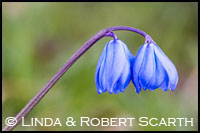introduction - galleries - technique - catalogue - notes - links - contact - blog - deep nature

Scilla
It?s spring; the time when people head outside to play. Photographers also head to gardens, parks and woodlands to enjoy the photo possibilities. Spring flowers are among the loveliest and most interesting subjects. The weather may be pleasant, but sunlight and wind are the flower photographer?s chief adversaries. Here are some techniques and equipment that we use which may be helpful.
Plants evolved to deal with those two natural forces: sunlight and wind. Photographers must do the same. Early morning and late afternoon light is often magical and lightly overcast skies allow for photography all day. Interesting subjects are often found on bright sunlit days when the light needs to be modified to obtain desirable results.
Leafy plants protect themselves from the deleterious rays by having reflective surfaces. Green foliage is similar to granite (though less so than water) in reflecting light that cameras record. Human eyes and brains do not notice these reflections. Humans can see into shadows better than do cameras. Cameras record harsh shadows and faded colors in bright light, especially at midday. Photographers often wonder why they did not capture the images they saw. Washed out colors and blocked out shadows can be overcome, even on a sunny day.
Most flowering forbs (herbaceous leafy plants that are not grasses) bend and nod, even wave, at the slightest breeze. Early Meadow Rue does not seem to need a breeze for its stamens to quiver. Unless the photographer?s planned composition involves a blur, most wind blown plant images will be discarded. Fast shutter speeds help in adequate light but other aids are required in low light. For bracing tall flowers, we use garden stakes topped with short pieces of soft clear plastic tubing into which inch-long narrow V cuts have been made. The stakes are braced on opposite sides of the stem below the flower and out of the frame with the notches gently holding the stem between them. Stems are less likely to be damaged than when using clamps that pinch.
Both problems (harsh light and wind) can be managed using photographers? white studio umbrellas that have been made square by releasing every other rib of the eight and tying them to the adjacent ribs with little white cable ties. We both carry two umbrellas that can be lined up on the windward side or propped opposite one another in a pyramid to shield the wind and diffuse the light. Bob usually carries a roll of ?stiffish? translucent plastic about 20 inches tall attached to two garden stakes to create a longer windbreak. The plastic sometimes reflects soft light back at the subject. When using white umbrellas to diffuse strong sunlight, it is necessary to shade the background as well as the subject to obtain proper exposure and good color. Sometimes all four umbrellas will be in a row inserted into green garden stake holders.
Blue flowers are another challenge on sunny days. It is difficult to capture the color of pretty blue Scillia or Phlox with film or digital cameras. Film often gives blue flowers a magenta cast. One of the advantages of digital captures is that camera raw pixels can be more easily encouraged to emulate the blue that the photographer saw. Some photographers prefer open shade under trees that allows the blue of the sky to be reflected down. We sometimes use a large diffuser made from translucent silk screen fabric to emulate open shade. We avoid direct sunlight that seems to filter out blue light, and heavily overcast days that subdue the blue to gray.
Our other indispensable tools are tripods, cable releases, reflectors and gardeners? knees. Tripods eliminate most camera shake and gardeners? knees help avoid bruises. It is difficult to concentrate on composition and wait for a lull in the wind when there are stones or wet ground. When our tripods are spread to ground level for a worm?s eye view, we can use our angle finder so we don?t have to lie on the ground to see through the viewer. Angle finder is a strange name for a right-angled periscope that lets one look down and still see through the view finder.
Another aid is a focusing rail on a tripod. These are especially useful high magnification of tiny flowers or a dew drops. We use it for high magnification (2X or 3X) when we combine extension tubes, teleconverters, and/or a two element close-up lenses with our macro lenses (1:1).
We sometimes use shock cords attached to our tripods to reduce camera shake when we use our longest lenses. One cord is looped over the lens shade screw and the other goes around a nylon screw in the quick release plate. We use cord barrel locks to maintain gentle tension for reducing vibrations.
The tiny electric blue Scilla was photographed between 10 a.m. and noon on a sunny breezy day. We would not have attempted photographing them without diffusing the light and blocking the wind. Don?t let too much sunshine and wind deter you from your photography.
? Linda & Robert Scarth, 2007.
